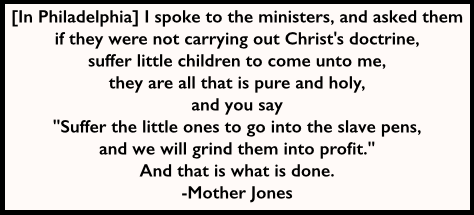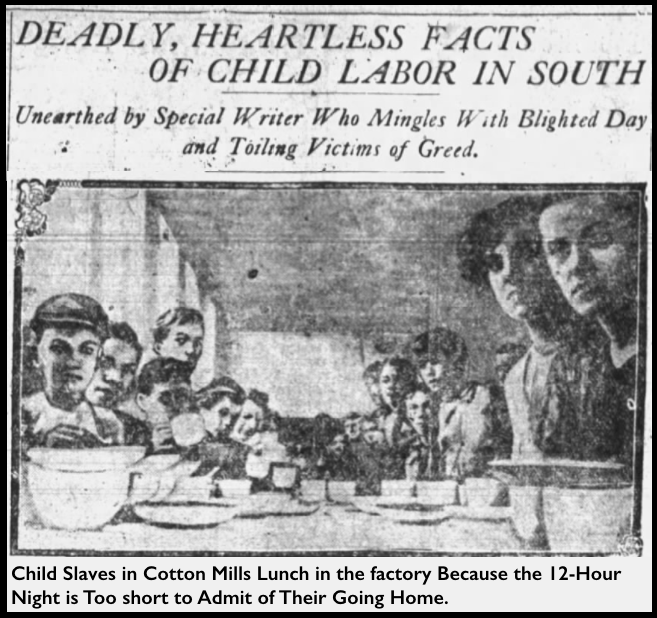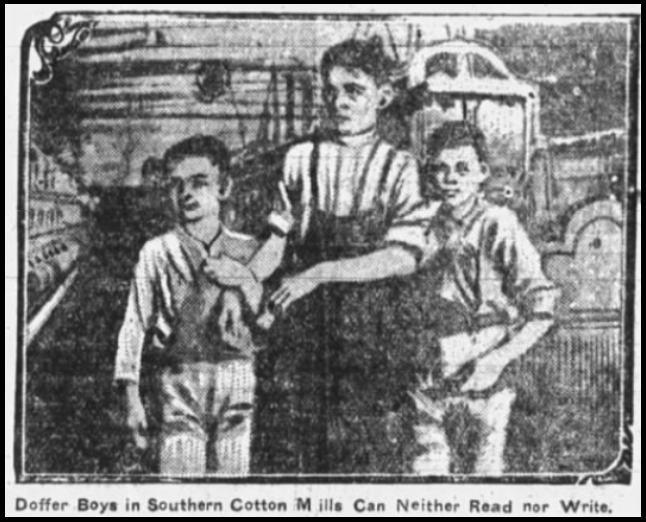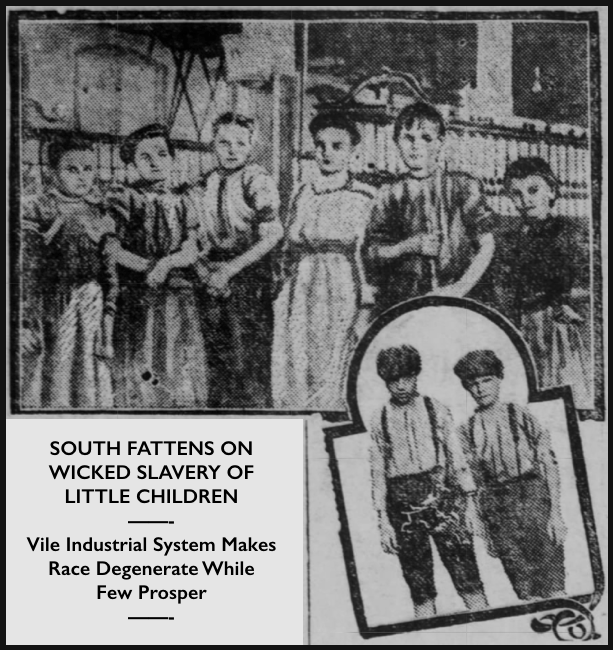
Hellraisers Journal, Tuesday October 29, 1907
Gaston County, North Carolina – Child Slaves of the Cotton Mills
From The Industrial Union Bulletin of October 26, 1907:
Child Slavery in the South
Gilson Gardner in Chicago Journal.
—–
What about child labor in the south? Is it really true that small children work in cotton mills at night? or are those stories exaggerated?
I came here to see, because Gaston county has more mills then any county in a state that has more mills than any state in the south.
I find: Little girls, of an age to still care for dolls, working all night in the mills, pacing up and down between the long spinning frames, in a jar and roar of wheels. I find bright-faced little American girls, 8 to 12 years of age, toiling bare-footed in the heat and flying lint. These children tell me they can not read the words on my business card, because they have “most forgot” what they learned in the “second reader.”
This is what I find in the magnificent new mills which have sprung up in the south-the little children harnessed in the treadmills which run twelve hours a day and twelve hours a night-to grind out dividends at 33 per cent, not counting sinking funds and new additions.
And yet people in Gastonia have the courage to say that the stories of child-labor are exaggerated, and that there is a lot of “sentimental stuff” and “poppy rot” (I quote from the local superintendent of public schools, J. O. Ray) written about this matter.
I confess to a sentiment when I think or write of what I saw. It is a sentiment in which sympathy and anger mix. It makes me yearn for things impossible-as that one fat statesman might be put in a cotton mill for just one trick of twelve long, heated hours, say in the mill of the Gastonia Manufacturing company, beside Pearl Thompson, “11 years next birthday, sir.”
Pearl has been three years in the mill and could show the statesman how to mend the threads, pick the cotton from the rollers and keep all wiped and clean. And twelve hours, without sitting down, without a recess or luncheon hour (the statesman would, like Pearl, carry a sandwich in one hand and tend the spindles with the other)-maybe this would give the statesman a new point of view on some phases of child-labor legislation which will be discussed at the forthcoming session of congress.
—–
I visited all the mills. There are nine large spinning and weaving mills. In every one I found children under 12.
I talked with Ada Sanders at the Clara mill. Ada was minding two spinning frames. There were others like her near by. She, said she was 11 going on 12. She has been nine months in the mill. School? She had been once for several months. Could she read “Not much.” An experiment showed this to be the case. Neither could she write. She did not know just now much she earned. She guessed she might get $3 “this week.”
This pretty little American child has become a “hand”-one of 60,000 under 14 years of age-by which the industry in the south has distanced New England, and the south is forging to the front with a prosperity unknown since slavery was abolished-the slavery, that is, of negroes. The negro race is still free. And now, god save them, the only slaves are white girls and boys [*].
At the “old Mill,” run by the Avon company, I found the same evening Pearl Thompson and Estelle Phillips, 11 and 13 years of age. I have told you about Pearl, Estelle is a duplicate.
I visited the Modena mill in daylight and talked with several little girls. One said she was “10 going on 11” another that she was “11 going on 12” both were experienced hands. Both were undersized. They had gone as far as third grade.
In the Flint mill I talked with a number of boys. Bright little Plato Smith said he was 10. In the mills two years. He was running a twisting machine, 25 cents a day. He weighted 58 pounds. He did not look strong. He could not read or write and had no hopes of school.
—–
Walter Walker, 11, who started work four years ago at 5 cents a day, now earns 75 cents to $1. He is a “doff boy.”
I talked to J. M. Jackson, a father of eight, employed at the Loray mill. He told of working two of his underage girls during the summer. When he attempted to remove them, the “mill people” objected, said they could not afford to let him occupy their house unless the children worked. The mother corroborated this.
“We would rather have the children,” explained Foreman Dobbins of Loray mill. “Their hands are more nimble and they earn more than the grownups.”
That is the trouble. The mills bid for the children-refuse to give them up-and the schools are emptied. And they tell you that outsiders ought not to meddle, and that congress had better let the states alone.
———-
[Photographs added.]
*Note: Gardner stated above:
The negro race is still free. And now, god save them, the only slaves are white girls and boys.
This statement is, of course, completely untrue. Millions of children, both black and white, toil away their childhood rather than go to school. And millions of wage workers, tenant farmers and sharecroppers, both black and white, are now forced to live and work under conditions of peonage, or near peonage.
SOURCES
The Industrial Union Bulletin
(Chicago, Illinois)
-Oct 26, 1907, p2
https://www.marxists.org/history/usa/pubs/industrialworker/iub/v1n35-oct-26-1907-iub.pdf
The Legal Status of the Negro
-by Charles Staples Mangum
The Lawbook Exchange, Ltd., 1940
(Search: “vi involuntary servitude”)
https://books.google.com/books?id=P2ViDnNezq4C
“Excerpt: Slavery By Another Name”
by Douglas A Blackmon
http://www.npr.org/templates/story/story.php?storyId=89051115
Slavery by Another Name:
The Re-Enslavement of Black Americans
from the Civil War to World War Two
by Douglas A. Blackmon
Icon Books, Oct 4, 2012
https://books.google.com/books?id=2v-BYWrjl9IC
IMAGES
Child Labor in South by G Gardner (x2), W-B Ldr p7, Oct 5, 1907
https://www.newspapers.com/image/118094943/
Child Labor in South by G Gardner, Evl Prs IN p4, Oct 9, 1907
https://www.newspapers.com/image/137625605/
See also:
Child Labor in the Carolinas.
by A. J. McKelway
Secretary for the Southern States
of the National Child Labor Committee, Nov 1908
-includes many photos by Hines
http://www.teachingushistory.org/documents/chldlbr21.pdf
Some Human documents resulting from investigations made in the cotton mills of North and South Carolina by A. E. Seddon, A. H. Ulm and Lewis W. Hine (staff photographer for Charities and the Commons) under the direction of the southern office of the National Child Labor Committee.



